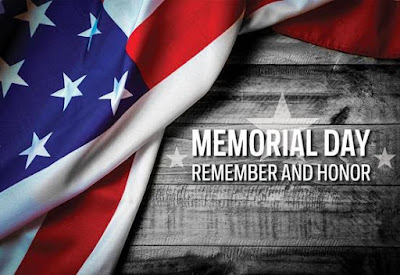Many celebrate
the long Memorial Day weekend with barbecues and family get-togethers, but
Memorial Day is so much more than a chance to kick off the summer months. At
its heart, Memorial Day marks a thoughtful day of observance, centered on
remembering and thanking the millions of Americans in uniform who gave their
lives for this country. Memorial Day's meaning is truly about those heroic
women and men, and the remarkable sacrifices they made.
Memorial Day
began a few years after the Civil War, in 1868. An organization of Union
veterans established the holiday, then known as Decoration Day, as a time to
decorate the graves of fallen soldiers with flowers. From then until the
present day, the solemn holiday has been formally observed at Arlington
National Cemetery in Washington, D.C.
In 2000,
Congress passed the National Moment of Remembrance Act, which encourages
Americans to observe a moment of silence at 3 p.m. local time to remember those
who have died in service.
Memorial Day
Facts
Memorial Day
was originally known as Decoration Day.
The holiday
began as a way to honor soldiers who died in the Civil War, but the day now
honors all U.S. veterans who have sacrificed their lives.
There’s a
specific way to display the American flag on Memorial Day, according to
the U.S. Flag Code: hoist the flag quickly up to full
staff at sunrise, then lower to half-staff until noon, and then return to the
top of the staff.
Many veterans,
as well as friends and family of veterans, make a pilgrimage to the Vietnam Veterans Memorial
in Washington, D.C., over Memorial Day weekend.
In 1971,
Memorial Day was established as a federal holiday taking place
on the last Monday in May.
Poppies have
become a symbol of Memorial Day because they are
mentioned in a 1915 poem by Canadian soldier John McCrae, “In Flanders Fields.”
Many
Americans mark Memorial Day with an official moment of remembrance
at 3 p.m. local time.
During the 3
p.m. moment of remembrance on Memorial Day, Amtrak conductors sound one long
whistle in honor
of those who have died in service.
Traditionally,
American presidents give a Memorial Day speech at Arlington National Cemetery
at the Tomb of the Unknown Soldier.
New York was
the first state to recognize Memorial Day as an
official holiday.
Some Southern
states celebrate a Confederate Memorial Day, or Confederate Heroes Day, in late
April, remembering the Confederate soldiers who died during the Civil War.
The first
Indianapolis 500 race took place on Memorial Day in 1911.
The Lincoln
Memorial was dedicated by then-Chief Justice William Taft on Memorial Day in
1922.
There is no
right or wrong way to celebrate Memorial Day weekend, for each person has their
own way of memorializing and honoring the fallen soldiers of the past. However you choose to commemorate
Memorial Day, be it with mournful reflection, hotdogs and happiness, or a mix of
both, we ask that you do so to honor the memory of those who, in the words of
President Abraham Lincoln, never forget those who “gave the last full measure
of devotion.”








